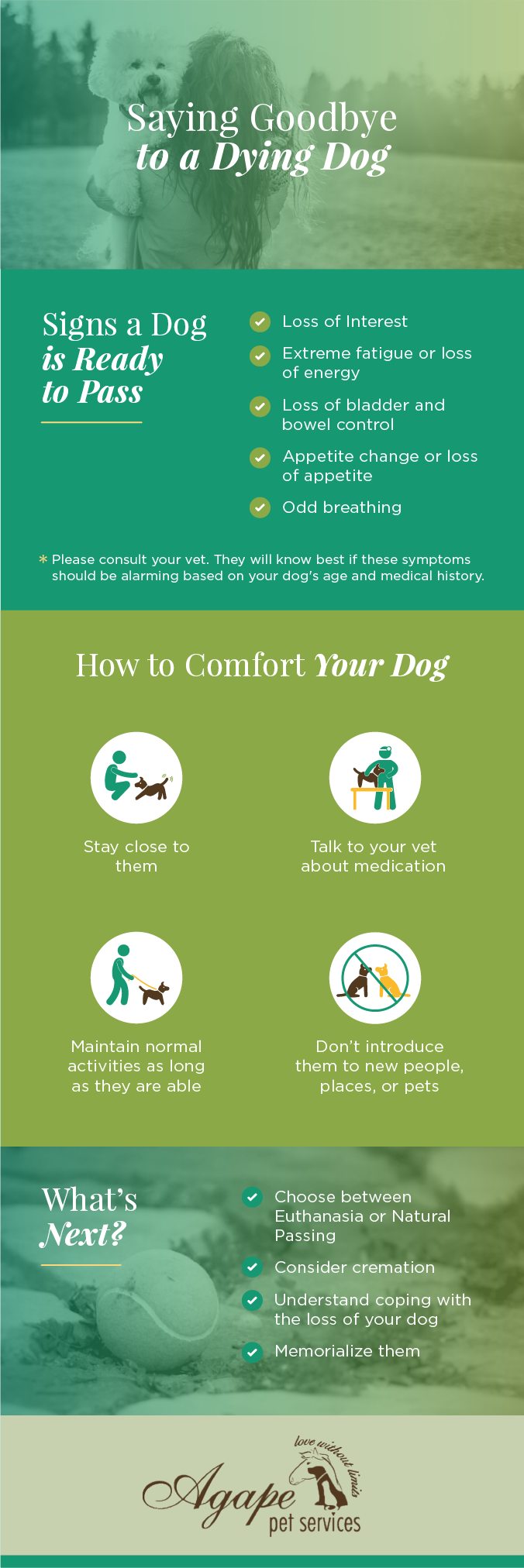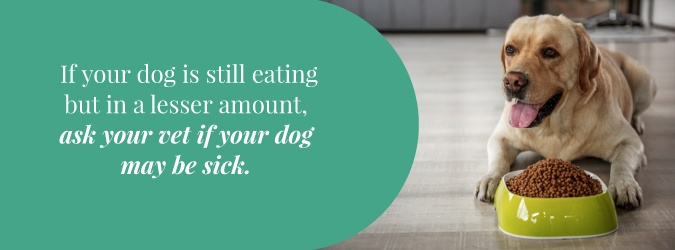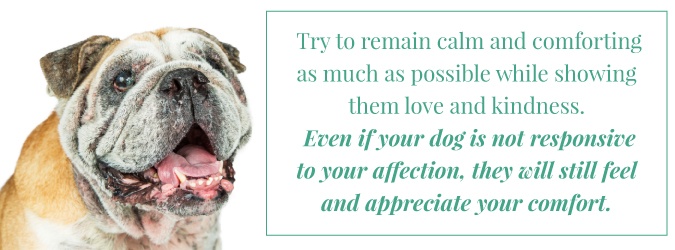Dog Behavior Before Death

Your dog is a beloved member of the family. While it is never pleasant to think about their passing, the time will inevitably come that you must say goodbye. Whether your dog has struggled with a terminal illness or is merely reaching old age, they may begin showing signs that their life is coming to an end. Recognizing the signs that a dog is dying will allow you and your family to prepare. You’ll be able to make arrangements for their final days, whether you let your dog pass away naturally or choose humane euthanasia.
Signs a Dog Is Ready to Pass

- Loss of Interest
- Extreme Fatigue or Loss of Energy
- Loss of Bladder or Bowel Control
- Loss of Appetite
- Labored Breathing
As a loving pet owner, you know your dog better than anyone and will notice when they are not acting like themselves. While each dog’s experience is different, there are similar patterns of behavior that may mean the end is close. If you find yourself asking “Is my dog dying?”, you should monitor your dog’s behavior for these five common signs that a dog is dying.
- Loss of Interest
As a dog draws closer to death, they may begin to lose interest in things and people around them. They may not be interested in people they love or their favorite treat or toy. It is normal if your dog no longer wants to play, as they will experience a loss of interest and a decrease in energy levels. Your dog may even stop responding to you or your family members entirely.A common reason dogs lose interest when they are dying is that their brain functions begin to shut down. They may experience mental confusion that causes them to appear detached. It is important to remember that even though your dog is uninterested, this does not mean they do not still care about you. Their love for you has not faded, they just do not have the energy to show it in the same way.
It is important to remember that even though your dog is uninterested, this does not mean they do not still care about you. Their love for you has not faded, they just do not have the energy to show it in the same way. - Extreme Fatigue or Loss of Energy
One of the most common signs that a dog may be dying is a severe loss of energy. Typically, a dying dog will lie in one place without moving around very much. This place may be a quiet corner of your home or somewhere secluded, and it may not be a spot where they usually lie. Your dog might not even have enough energy to lift their head.If your dog is still moving from place to place around your home but does so more slowly, this may simply be a sign of old age. Especially if your dog has a chronic illness, they may show fatigue even if they are not nearing the end. If your dog is no longer lively but does not show other signs that they may be reaching the end, talk to your vet to see if another factor is involved. - Loss of Bladder and Bowel Control
When a dog is dying, they often lose control over their bladder and bowels as their organs begin to shut down. This can lead to your dog peeing or experiencing a bowel movement wherever they are lying. Even if your dog is very well-trained, they may not have the energy to get up to relieve themselves.If your dog cannot control their bladder, be sure to practice good nursing to keep your dog as healthy as possible. Change or wash your dog’s bed when it becomes soiled and keep your dog clean to prevent them from developing sores. While it can be challenging to care for a dog that cannot control their bladder or bowels, know that this is a regular occurrence. Try to remain patient and calm, remembering that your dog cannot control their behavior at this stage. - Appetite Change or Loss of Appetite
A dying dog will experience appetite changes and may lose their appetite entirely. No matter what food or treats you offer, a dog that has lost their appetite will typically refuse both food and water. The closer your dog is to dying, the less of an appetite they will have. If your dog is not eating at all, there is a good chance they are close to the end. As your dog’s digestive organs shut down, they will not experience the sensation of hunger or thirst. Visible weight loss will often accompany this decrease in appetite.Even if your dog does still consume food or water, they may experience digestive issues. In addition to an inability to control their bowels, a dying dog may vomit after eating or drinking. If your dog is not able to keep water down, they may become dehydrated. During this time, you may try to keep your dog hydrated by giving them water from a water dropper or turkey baster. However, if your dog does not swallow the water, there is not much you can do. Continue to offer your dog food and water, but do not force them to eat or drink if they are not able to. Sometimes a dog will experience a natural decrease in appetite as they age or if they are ill, which does not necessarily mean they are dying. If your dog is still eating but in a lesser amount, ask your vet if your dog may be sick.
Sometimes a dog will experience a natural decrease in appetite as they age or if they are ill, which does not necessarily mean they are dying. If your dog is still eating but in a lesser amount, ask your vet if your dog may be sick. - Odd Breathing
When a dog is dying, they may experience difficulty breathing, and their breathing may become shallow. You may also notice that your dog seems to struggle to catch their breath, and their breathing may be uneven. The time between each inhale and exhale may become longer. If your dog is breathing weird, they may be close to the end.The more symptoms your dog shows at the same time, the more likely it is that your dog is dying. If your dog is younger and shows a few of these symptoms, talk to your veterinarian, as your dog may be sick but not dying. Once your dog reaches old age, showing a combination of these symptoms is likely a sign that your dog is going to pass.Even if your dog is older, it is smart to take them to the vet to confirm your suspicions. Your vet will likely be able to assess the health of your dog without performing tests to determine whether your dog is dying or simply ill.
Comforting a Dying Dog

Once you recognize the signs that your dog is dying, the best thing you can do is try to make them as comfortable as possible in their final days. While it may be frustrating and challenging to deal with symptoms like vomiting or loss of bladder control, remaining patient with your pet in their old age will make the transition easier for both of you. Here are four tips about how to comfort a dying dog to make their passing as peaceful as possible.
- Stay Close to Them
Many dogs will seek comfort during this time and may desire more attention and care. Sit with your dog and pet them as much as you can. Talk to your dog in a soothing voice and tell them everything will be okay. Dogs are very sensitive to your emotions, so it can be distressing to your dog if you show your sadness around them. Try to remain calm and comforting as much as possible while showing them love and kindness. Even if your dog is not responsive to your affection, they will still feel and appreciate your comfort.
- Don’t Introduce Your Dog to New People or Places
Try to keep your dog in places where they are comfortable and avoid introducing them to new locations. New areas can cause too much stimulation and are distressing to a dog that is already experiencing mental confusion.Avoid having new people around your dog, too, as that may also be disorienting to them. When people interact with your dog, make sure they are gentle and kind. Be especially cautious with children and others who may not understand the situation. It may be helpful to explain to your friends and family that your dog is growing old and will not be able to play in the same way. - Maintain Normal Activities as Long as Your Dog Is Able
As your dog becomes older, continue to take them on walks and play with them as long as they are capable. As your dog’s health declines, they may not be able to participate in these activities as much or as rigorously, but they’ll still enjoy their daily routine and having a normal life. Monitor your dog’s behavior and never push them to do more than they can do. Adapt your regular habits to suit their abilities, but remain attentive and caring. - Talk to Your Vet If Medication Is Needed
If your dog has a terminal illness, medication may be helpful to control their symptoms or ease their pain. Dogs that are ill can often live for a long time with the proper medicine and care. Medication can also alleviate some symptoms a dog experiences when they are dying, such as vomiting or shaking. Talk to your veterinarian to see if medication or treatment can help your dog. However, keep in mind that medications and treatments cannot prevent your dog from passing away, they can only make your pet more comfortable in their last days.
I Think My Dog is Dying: What’s Next?

Deciding how to navigate your dog’s final days can be extremely difficult. It can be an emotional time for you and your family, but it’s essential to make the best choice for your pet. Some families may choose to let their dog pass away at home. For others, humane euthanasia may be the best option. In general, you can take the following four steps to work through the loss of your pet.
- Choose Between Euthanasia and a Natural Passing
Sometimes, prolonging your dog’s life through medication will only lead to more pain and suffering. As a loving pet owner, you want to do what is best for your dog. Evaluate your dog’s quality of life and decide if euthanasia is the best choice for them.Many pet owners experience extreme guilt when choosing to put a pet to sleep. However, it is sometimes the best choice to end the needless suffering of your beloved pet. Ensuring your pet has a peaceful end can be an act of compassion and love. No matter what you choose, make sure you are keeping your pet’s best interest in mind. While it may be challenging to say goodbye to your pet, do not prolong your dog’s suffering just because you do not want to see them go.Choosing euthanasia for your dying dog also allows you to plan the right time and place for your dog’s last moments. You will be able to prepare for their passing and ensure they are comfortable. Having the opportunity to say goodbye can also be very helpful for kids and families to experience a sense of closure.If you do choose to put your dog to sleep, make sure you know what to expect before you arrive for the euthanasia procedure. Ask your vet any questions you may have about the process, so you are prepared. You may choose to be present for the procedure, or have a final goodbye afterward. It is up to you how you want to spend your dog’s final moments, and always allow yourself to respond however you would naturally. Becoming emotional is entirely normal when experiencing the loss of a beloved dog. - Consider Cremation
Many people choose cremation after the death of a dog because it allows them to keep a part of their dog close to them. Cremation provides the option of keeping the remains in a memorial urn or scattering them somewhere that the dog loved or that holds significance. You may also choose to bury the cremains. If you choose cremation, you have the option of a private or communal cremation. In a private cremation, you may be able to attend the cremation and will receive your pet’s individual cremains. While an individual cremation can be more expensive, it allows you to share a special and private time with your family. In a communal cremation, the cremains you receive may not be only your pet’s. A communal cremation is often less expensive and is still a dignified and respectful option for handling your dog’s remains.
If you choose cremation, you have the option of a private or communal cremation. In a private cremation, you may be able to attend the cremation and will receive your pet’s individual cremains. While an individual cremation can be more expensive, it allows you to share a special and private time with your family. In a communal cremation, the cremains you receive may not be only your pet’s. A communal cremation is often less expensive and is still a dignified and respectful option for handling your dog’s remains. - Understand Coping With the Loss of Your Pet
After the death of a pet, allow yourself time to grieve. Your dog has been a member of the family, and mourning their loss is entirely natural and normal. Grieving is also an important part of the healing process. Here are a few things you can do to help cope with the loss of a pet:- Give Yourself Time: Set aside time with your family to sit together and mourn. You may want to look at pictures of your pet or share stories about good times you spent with your dog. Allow yourself to cry or experience emotions however you need.
- Talk to a Friend: Share your feelings with a friend or someone who has experienced a similar loss. Talking about your emotions can be a helpful way to move forward.
- Ask for Help With the Arrangements: After your pet passes, you need to decide what to do with their body, whether you choose burial or cremation. You may want to spread or bury the cremains or commemorate your pet in some other way. Making arrangements after the death of a dog can be very difficult, so do not be afraid to ask for help from your vet, a friend or a local pet cemetery or crematorium.
- Take Care of Yourself: Grieving can have an impact on your body’s physical health. Be sure to take care of yourself while you are mourning by exercising, eating healthy and getting a good night’s rest. Maintaining your health will also help to boost your mood.
The way you cope with the loss of your dog will look different from the next person’s reaction. Be kind and allow yourself the proper time to grieve.
- Memorialize Your Pet
After your dog passes, you may want to memorialize your pet in a special way. There are many great options for cherishing the memory of your beloved dog, including:- A Decorative Urn: You may want to choose a decorative dog urn with a nameplate, engraving or image of your pet. Choosing a personalized urn for your dog’s cremains can be a great way to keep them close to your heart.
- A Special Memento: Clay paw prints or nose prints can be a special way to remember your pet. You may also order jewelry or glass beads that contain a small portion of your dog’s cremains.
- A Pet Portrait: Hanging a painting of your pet can help you remember them and also look great in your home.

Contact Agape to Help You Say Goodbye
At Agape Pet Services, we can help you say goodbye to your beloved dog with care and dignity. We offer private or communal dog cremations that you or your family can attend if you desire. Plus, our decorative urns and other keepsakes are a great way to remember your dog and commemorate your love for them. We also offer 24/7 in-home pickup services to make your pet’s transition as smooth as possible.
Dealing with the death of a dog is never easy, but by recognizing the warning signs, you and your family will be able to prepare. If you believe your dog is dying, contact our compassionate team at Agape Pet Services to discuss cremation options, or explore our memorialization items online to find the perfect way to commemorate your best friend.
 It is important to remember that even though your dog is uninterested, this does not mean they do not still care about you. Their love for you has not faded, they just do not have the energy to show it in the same way.
It is important to remember that even though your dog is uninterested, this does not mean they do not still care about you. Their love for you has not faded, they just do not have the energy to show it in the same way. Sometimes a dog will experience a natural decrease in appetite as they age or if they are ill, which does not necessarily mean they are dying. If your dog is still eating but in a lesser amount, ask your vet if your dog may be sick.
Sometimes a dog will experience a natural decrease in appetite as they age or if they are ill, which does not necessarily mean they are dying. If your dog is still eating but in a lesser amount, ask your vet if your dog may be sick.
 If you choose cremation, you have the option of a private or communal cremation. In a private cremation, you may be able to attend the cremation and will receive your pet’s individual cremains. While an individual cremation can be more expensive, it allows you to share a special and private time with your family. In a communal cremation, the cremains you receive may not be only your pet’s. A communal cremation is often less expensive and is still a dignified and respectful option for handling your dog’s remains.
If you choose cremation, you have the option of a private or communal cremation. In a private cremation, you may be able to attend the cremation and will receive your pet’s individual cremains. While an individual cremation can be more expensive, it allows you to share a special and private time with your family. In a communal cremation, the cremains you receive may not be only your pet’s. A communal cremation is often less expensive and is still a dignified and respectful option for handling your dog’s remains.

